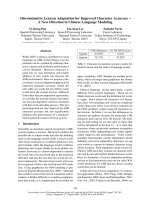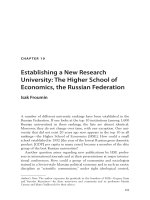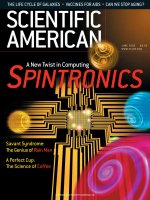a new holographic in university
Bạn đang xem bản rút gọn của tài liệu. Xem và tải ngay bản đầy đủ của tài liệu tại đây (2.47 MB, 44 trang )
A
New
Holographic
Model
of
Spacelike
Singulari7es
Gary
Horowitz
UC
Santa
Barbara
Gauge/gravity
duality
is
a
powerful
tool
to
try
to
understand
physics
near
spacelike
singulari7es.
It
maps
the
problem
into
a
problem
in
ordinary
QFT.
We
will
focus
on
cosmological
singulari7es.
We
need
to
construct
asympto7cally
AdS
solu7ons
which
evolve
into
(or
from)
a
singularity
that
extends
all
the
way
out
to
infinity.
Outline
Discuss
two
examples
of
cosmological
singulari7es
in
AdS
and
what
is
know
about
the
dual
CFT
descrip7on:
1) Review
older
work
with
Hertog
(2005)
2) Work
in
progress
with
Hertog
and
Engelhardt
First
holographic
model
of
a
cosmological
singularity
Hertog
and
GH,
hep-‐th/0406134,
hep-‐th/0503071
Consider
gravity
in
AdS4
coupled
to
a
scalar
with
poten7al
V(φ)
having
m2
=
-‐2.
One
example
coming
from
a
trunca7on
of
N
=
8
SUGRA
is:
p
V ( ) = 2 cosh 2
Solu7ons
must
approach
2
dr
ds2 = (r2 + 1)dt2 + 2
+ r2 d⌦
r +1
In
all
asympto7cally
AdS
solu7ons,
the
scalar
field
falls
off
like
If
α=0
or
β=0,
AdS
is
stable.
Consider
a
new
boundary
condi7on
β=kα2
(Hertog
and
Maeda).
This
is
also
invariant
under
all
asympto7c
AdS
symmetries.
Claim:
For
all
nonzero
k,
there
are
solu7ons
that
evolve
to
a
big
crunch.
Start
by
solving
the
Euclidean
field
equa7ons
with
SO(4)
symmetry
Get
ODE’s.
Pick
φ
at
the
origin
and
integrate
out.
Asympto7cally
find
Define
k
by
β=
kα2.
φ
decays
monotonically:
φ
ρ
Restric7ng
to
the
equator
of
the
three-‐sphere,
we
get
ini7al
data
for
a
Lorentzian
solu7on.
The
evolu7on
of
this
ini7al
data
can
be
obtained
by
analy7c
con7nua7on.
(Coleman
and
De
Luccia,
1980)
The
Euclidean
origin
becomes
a
Lorentzian
lightcone.
Outside
the
lightcone
everything
is
smooth
and
bounded.
Inside
the
lightcone
the
solu7on
evolves
like
an
open
FRW
universe:
The
field
equa7ons
imply
that
the
scale
factor
vanishes
in
finite
7me,
producing
a
big
crunch.
Big
crunch
Time
symmetric
ini7al
data
Asympto7c
AdS
Big
bang
This
looks
like
Schwarzschild
AdS,
but:
(1) Infinity
is
not
complete.
(2) “Horizon”
is
just
the
lightcone
of
the
origin.
CFT
Descrip7on
This
is
the
2+1
theory
on
a
stack
of
M
2-‐branes
(Aharony,
Bergman,
Jafferis,
and
Maldacena,
2008).
The
theory
contains
eight
scalars.
With
β=0
boundary
condi7ons,
the
bulk
scalar
φ
is
dual
to
the
dimension
one
operator
Our
new
boundary
condi7on
corresponds
to
adding
to
the
field
theory
ac7on
the
term
(Wiken;
Sever
and
Shomer):
CFT
is
like
a
3D
field
theory
with
poten7al
start
here
V
ϕ
This
field
theory
is
sick:
ϕ
rolls
down
the
poten7al
and
reaches
infinity
in
finite
7me.
This
is
the
analog
of
evolving
to
the
singularity
in
the
bulk.
Update
Maldacena
(1012.0274)
pointed
out
that
if
we
use
dS3
slices
near
infinity,
then
φ
is
constant
on
each
slice.
So
if
we
view
the
dual
theory
as
living
on
de
Siker
space,
then
our
solu7ons
exist
with
boundary
condi7on
β
=
const.
This
corresponds
to
adding
a
single
trace
operator
O
to
the
CFT
on
de
Siker.
This
is
like
a
mass
term.
Field
theory
remains
well
defined!
Any
renormalizable
but
not
conformal
deforma7on
of
the
QFT
on
dS3
will
be
dual
to
a
crunch
(Harlow
and
Susskind,
1012.5302).
Problem
now
is
how
to
describe
the
region
near
the
singularity
in
the
dual
theory.
If
you
rescale
back
to
sta7c
cylinder,
the
mass
deforma7on
becomes
7me
dependent
and
blows
up
when
the
singularity
hits
the
boundary
(Barbon
and
Rabinovici,
1102.3015).
A
new
holographic
model
of
cosmological
singulari7es
(Engelhardt,
Hertog,
GH,
to
appear)
The
new
model
has
the
advantage
that
1) The
dual
CFT
is
well
defined
2) One
can
access
the
region
near
the
singularity
by
boundary
operators.
The
bulk
solu7on
Now
work
with
a
5D
bulk
and
no
scalar.
Solu7ons
to
Einstein’s
equa7on
can
be
obtained
by
star7ng
with
AdS5
1
ds = 2 (⌘µ⌫ dxµ dx⌫ + dz 2 )
z
2
and
replacing
ημν
with
any
Ricci
flat
metric.
We
will
use
the
Kasner
metric:
ds2 =
dt2 + t2p1 dx21 + t2p2 dx22 + t2p3 dx23
X
X
pi = 1 =
p2i
i
i
2
t
ds = 2
z
2
✓
2
dt + t
2p1
dx21
+t
2p2
dx22
t2
+t
2p3
dx23
+ dz
Lesng
t
=
eτ
,
the
boundary
metric
becomes
an
anisotropic
version
of
de
Siker
in
flat
slicing
X
2
2
2(1 pi )⌧
2
ds
=
d⌧
+
e
dx
i
i
Our
bulk
solu7on
has
a
dila7on
symmetry
z ! z, t ! t, xi ! (1 pi ) xi
which
acts
on
each
surface
of
constant
t/z.
2
◆
t/z
large
t/z
=
1
t/z
small
t
=
0
singularity
z
=
0
boundary
at
infinity
Calcula7ng
two-‐point
func7on
The
two
point
func7on
of
an
operator
in
the
CFT
with
large
dimension
Δ
can
be
calculated
using
spacelike
geodesics
in
the
bulk
with
endpoints
on
the
boundary
(see
also
Hubeny’s
talk):
0
Lreg (x,x0 )
h | O (x) O (x ) | i = e
where
Lreg
is
the
regulated
length
of
the
geodesic.
x2
=
x3
=
0
t
=
1
O
O
-‐x0
0
x0
x1
Bulk
geodesics
effec7vely
travel
in
3D
space7me
1
2
ds = 2 ( dt2 + t2p1 dx2 + dz 2 )
z
Using
x
as
a
parameter
along
the
geodesic,
t(x)
sa7sfies
00
0
2
2p1
t(x)t
(x)
=
p
[2t
(x)
t(x)
]
1
By
symmetry,
t
0
(0)
=
0
,
so
for
p1
<
0,
geodesics
bend
toward
the
singularity
and
for
p1
>
0
they
bend
away.
p1
>
0
p1
<
0
t
=
0
singularity
boundary
at
infinity
Length
of
geodesics
Using
t
as
the
parameter,
the
geodesic
is
given
by
X(t),
Z(t).
Its
length
is
Z
i1/2
1 h
2p1 ˙ 2
2
˙
L
=
1
+
t
X
+
Z
dt
Z
t2p1 X˙
δ
L/δ
X
=
0
implies
Z[· · · ]1/2 = const
Z 2p1 ˙
t X
So
L /
dt
2
Z
Simple
example
1:
Pure
AdS
In
pure
AdS,
the
geodesics
stay
on
a
constant
7me
surface.
With
UV
cut-‐off
z
=
ε,
their
length
is
✓
◆
2x0
L = 2 ln
= 2 ln(Lbdy ) 2 ln ✏,
✏
We
regulate
this
by
dropping
the
last
term.
So
2
hO(x0 )O( x0 )i = Lbdy
as
expected
for
a
CFT.
2:
Isotropic
de
Siker
Bulk
is
again
pure
AdS
wriken
in
the
form
✓
◆
2 2
2
i
2
H t
dt + dxi dx + dz
2
ds =
z2
H 2 t2
With
Hτ
=
ln(Ht),
the
boundary
metric
is
ds2 = d⌧ 2 + e 2H⌧ dxi dxi
Geodesics
are
the
same,
but
cut-‐off
is
now
δ
=
ε/H
and
Lbdy
=
2x0/H,
so
effect
of
H
cancels
out.
L = 2 ln
✓
2x0 H
H ✏
◆
= 2 ln Lbdy
2 ln
So
in
de
Siker
space:
2
hO(x0 )O( x0 )i = Lbdy
just
like
flat
space.
It
is
independent
of
the
Hubble
constant.
The
case
p1
=
-‐1/4
1
ds = 2 ( dt2 + t
z
1/2
Recall:
dx2 + dz 2 )
Geodesic
equa7on
can
be
solved
analy7cally
using
w
=
t1/2
as
the
parameter:
4p
X(w) =
c + w(8c2 4cw + 3w2 )
15
Z(w) = 4 ⇥c(1 w)[(3c 1)(w + 1) w2 )]⇤1/2
3
c
fixes
the
boundary
separa7on:
Z(1)
=
0,
so
Lbdy
=
2
X(1)
2









